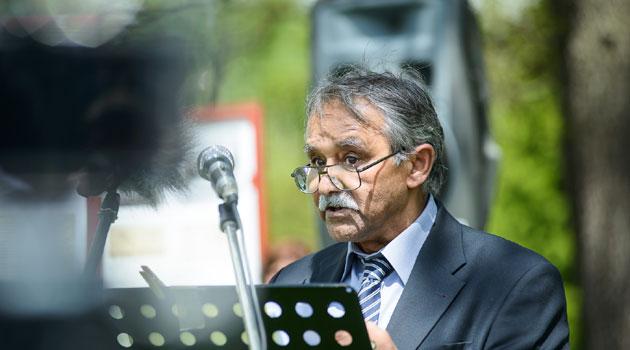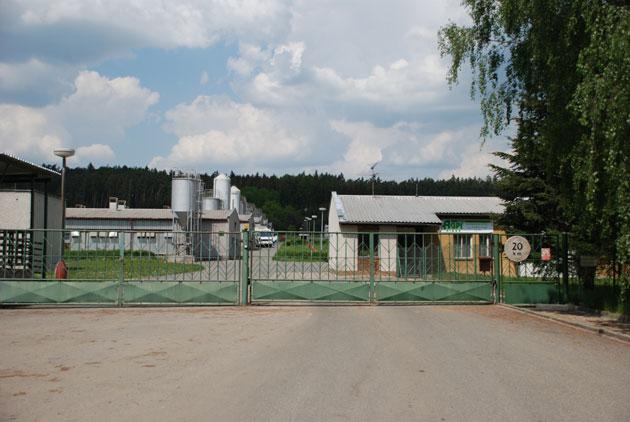Closing speech by Čeněk Růžička at Lety u Písku: We are not giving up our fight to restore dignity to the Romani victims of the concentration camp

The traditional commmemorative ceremony at Lety u Písku was brought to an end today by Čeněk Růžička, chair of the Committee for the Redress of the Roma Holocaust (Výbor pro odškodnění romského holocaustu – VPORH). In his closing speech he summarized the history of the efforts to remove the pig farm that occupies the site of the former concentration camp, which news server Romea.cz is publishing here in full translation.
Closing speech by Čeněk Růžička during the 2017 commemorative ceremony at Lety u Písku
Friends, we have listened to many speeches here, and some of them have included the anticipation that the industrial pig farm will be removed from the location where, during Nazism, the lives of hundreds of Romani and Sinti people came to an end because of their origins. We surviving relatives of the victims were surprised by the Government’s recent resolution on this issue, and given the other promises about the farm that have been made, we received the news with a certain dose of caution – but at the same time, along with many other citizens here, we hope that finally this place, connected with the murders of hundreds of victims, will receive the full recognition we have all awaited together for more than 40 years.
I am a descendant of Czech traditional travelling Romani people, I was born after the war in 1946, and I am marked by the unbelievable fate of my parents, for whom the Nazis and their underlings prepared a Hell on Earth during the Second World War. We Czech Roma are traditional and live according to the principles of Romani tradition.
One of those is the principle that we show the gravesites of our loved ones the appropriate reverence. This aspect of behavior is shared by many people besides us, though – it is share by all of you.
Because of this principle, the members of our association are unable to reconcile themselves to the disgrace this society has subjected us to, the scandal that has persecuted us for more than 40 years in the form of this pig farm on the site of a former concentration camp. In 1997, after learning of the state of the location where my family members died, I became aware of my second-class citizenship in this society.
Until that time I had known nothing of the concentration camp at Lety – my parents had never said anything to me about it before, because they were afraid I would end up in jail as a result of my responding to the information. I set out to achieve a remedy for this situation.
With the surviving prisoners of the concentration camp, with the family members of prisoners, and with like-minded individuals, we established a civic association in 1998 and began our fight to restore dignity not just to the victims of this camp and to the Romani nation as a whole, but also to the Czech nation, because the current state of the site of the former concentration camp is incomprehensible to our European fellow citizens, and they condemn the citizens of this country and its Government for facilitating this disgrace. We never suspected that we would have to fight every step of the way, that this would be a fight without a conclusion, that it would involve a never-ending dialogue with irresponsible politicians and with society, irrespective of what other problems we faced or who held what beliefs about us.
Ladies and gentlemen, today almost nobody dares to reject the information we are communicating to the public. You can review some of that information at our exhibition here today.
This year we are presenting this information around Prague. We are gratified that the mayors of the municipal departments of Prague, irrespective of their political affiliations, are helpfully providing their auspices to our presentation of this traveling exhibition, called “A Vanished World”.
If the Czech Government actually does buy out the pig farm, they will not have to be concerned that the citizens’ reactions to such a move might be negative. Rather, citizens – including us – will breathe a sigh of relief, and they will evaluate the removal of the pig farm from this concentration camp site as a proper act of state-building.
Since 1998, we have organized countless events which have convinced a large part of the public, as well as politicians (with a few exceptions) as to what life actually was like for our people here at Lety and in the Protectorate as such. That same year, the representatives of our Committee became members of a mixed historical-societal commission at the Office of the Government of the Czech Republic.
That commission prepared material that became the starting point for the Government to decide what to do next in the matter of the former concentration camp sites. In 2001 and 2002, with the financial support of the German Foreign Ministry and the Government of the Czech Republic, we implemented a project of installing memorial plaques with the names of 180 victims of the racial violence at the Lety camp who are buried at the cemetery in Mirovice, and in 2002 we created a memorial there, as envisioned by the Romani victims of Nazism and their family members, in the form of a set of sculptures of three women, larger than life-size, to accompany the plaques, which primarily bear the names of the child victims of the camp.
In 2005 we created an exhibition called “Lety – History of an Unmentioned Genocide” and presented it in the building of the European Parliament in Brussels at an event attended by most of the Members of the European Parliament. It was subsequently shown both in the Czech Chamber of Deputies and in the Czech Senate.
Thanks to the call by the European Parliament that same year for the operation of the pig farm on the site of the former concentration camp to be closed and for an appropriate memorial to be established, there was an extensive discussion in the Czech media of this issue and the broader public was informed about the fates of our people more specifically. The scandal of Lety, over time, achieved an even more obviously international character.
In 2006, at the National Gallery in Prague, we presented an extensive traveling exhibition entitled “The Romani Holocaust – Genocide of the Sinti and Roma and Racism in Europe Today”, with the support of the Czech-German Fund for the Future and the Ministry of Culture of the Czech Republic. The exhibition was created by the Documentation and Cultural Center of German Sinti and Roma, headquartered in Heidelberg, Germany.
To create that exhibition we contributed unique photographs from that era from private archives. In 2007 the Documentation Center, in collaboration with our Committee, the Museum of Romani Culture, and other Romani organizations abroad representing Holocaust victims, presented that exhibition in the main hall of the United Nations in New York. Also in 2007, in collaboration with the victims’ family members, we created the travelling exhibition entitled “A Vanished World.”
That exhibition was the first attempt to present the Czech public with the actual lives of the indigenous Czech Roma and Sinti prior to their imprisonment in the Nazi concentration camps. It was first opened on 5 September 2007 at the National Gallery in Prague by Czech President Václav Klaus.
After the surprisingly big interest shown in the exhibition we showed it once more elsewhere in Prague and then brought it to the public over the course of two years in Brno, Chomutov, Karlovy Vary, Mladá Boleslav, Opava, Ostrava, Plzen and Ústí nad Labem. It is still possible to organize a showing of this exhibition by contacting us; it provides clear information about what happened to Romani people during Nazism and how they used to live before the Nazis and their underlings began to persecute them as an inferior race.
Ladies and gentlemen, at first glance, in comparison with the Nazi extermination camps such as the ones at Auschwitz or the concentration camps at Ravensbrück or Terezín, the camps at Hodonín and Lety might appear insignificant. However, in the history of what is today the tiny number of indigenous Czech Roma and Sinti, these camps are of enormous significance.
In both camps, under terrifying conditions, children, men and women perished. Those who survived were marked by the torture they suffered for their entire lives.
Many suffered both mental and physical consequences. The ethnic group of Romani people indigenous to the Czech lands has also disappeared from public awareness as a consequence of these events.
In July 2012, Czech Prime Minister Petr Nečas visited this remembrance site at Lety and publicly summarized the consequences of an order issued by the general commander of the Protectorate Police, emphasizing, and I quote: “This date can be considered the beginning of the genocide against the Roma and Sinti, which led as a result to the practical liquidation of this minority on the territory of the Protectorate. Romani people, therefore, in terms of the proportion of their population, are those who have made the greatest sacrifice on our territory during the Second World War, and thus their fate is an inextricable component of the tragic history of our country.”
After that, the Prime Minister recalled the involvement of the Czech authorities at that time in the genocide of the Roma. I don’t know whether that can be considered a success – others can be the judge of that.
It is primarily through the patient publicizing of clear facts about the lives of our Romani family members in both of the concentration camps here that even high-level politicians today, irrespective of the societal response, are discussing Czech co-responsibility for the genocide of our Romani people, absolutely without hesitation. We have also persisted with our annual convening of these commemorative ceremonies here at the Lety Memorial.
To a great degree, we have also contributed to the removal of the recreation buildings from the site of the concentration camp at Hodonínek u Kunštátu, and perhaps the most important thing is that the scandal of the pig farm at Lety is living a life of its own. Unfortunately, the tragic site of our families’ deaths continues to be defaced by that farm.
Friends, the current state of the site of the former camp symbolizes the position of Romani people in this society, and by attending this ceremony, you are showing us that you are not indifferent to our fate. We sincerely thank you for coming and we hope that next year, when we meet here again, the pig farm operations will no longer be defacing the place where our Romani people met their deaths.
Until this same time next year, farewell.
